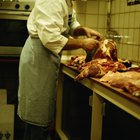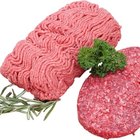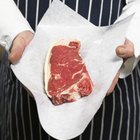
A beef steer is a very large animal, with a complex network of muscles supporting its skeleton and being supported in turn. Each muscle and group of muscles varies widely, with some providing tender, quick-cooking cuts and others needing long, slow cooking to tame their toughness. The rib eye and filet, or tenderloin, are two of the tenderest muscles to be found anywhere on the steer. However, they come from different areas on the animal.
Primal Needs
The tenderest cuts of beef come from the long muscles that support the spine, running between the relatively tougher muscles of the shoulder at front and the round at the animal's rear. These long muscles are divided into two major cuts, and these are among the cuts called "primals" by chefs and meat cutters. The front half of the muscle is the rib primal, and the rear half is the loin primal. Rib cuts, including the rib eye, come from the rib primal and the front half of the steer. Loin cuts, which include the filet, come from the loin primal and the rear half of the steer. It's physically impossible for them to both occur in the same cut.
A Closer Look at the Eye
The showpiece cut taken from the rib primal is a large standing rib roast, often called prime rib, which includes the first seven ribs and the tender muscles that overlay them. The cut can be sold as a large bone-in roast, cut into superlatively tender steaks with or without the bone, or trimmed of its bones to make a rib eye. The eye is the central muscle of the rib group, a roughly cylindrical section of unusually tender and well-marbled beef. Whether roasted whole or sliced for grilling steaks, it's one of the tenderest and most flavorful pieces of beef.
Finding the Filet
The whole fillet is not unlike the rib eye, a roughly cylindrical cut that's unusually tender. However the fillet is much leaner than the rib eye, which has more marbling and also contains thick veins of fat. Some diners prefer the fillet for its leanness and unsurpassed tenderness, while others favor the rib eye for its richness and better flavor. Both are premium cuts. Porterhouse and T-bone steaks fall into the same premium category, combining a section of the strip loin and a section of filet in each steak.
Confounding the Issue
That combination of strip steak and filet in one premium package might be why some diners expect to find a filet portion on their equally-costly rib eyes. In truth the steak often does contain two separate muscles, the eye itself and the cap muscle. The cap is the relatively flat piece of muscle that curves around the outside of a rib eye, joined to the eye muscle by a band of fat. It's very tender and well-marbled, and some butchers separate it from the rib eye for sale as a separate piece of high-end beef.
Related Articles

Do Filet Mignon Steaks Come From Female ...

What Is the Difference Between a Prime ...

Cuts of Meat From a Front Quarter of ...

What Cuts of Meat Are Used for Ground ...

Filet vs. Strip vs. Sirloin

Different Cuts of Steak

Is the Rib Eye or Sirloin a Better Cut?

Choice Vs. Prime Beef Grades

Types of Steak: Rare and Medium Rare
How to Cook Buffalo Fillet

Meat Parts of a Lamb
Difference Between Ribeye Steak & ...
What Cuts of Beef Come From a Hind?

Tenderloin Filet Vs. Top Sirloin

The Different Cuts of Beef: Sirloin, ...

Types of Pork Chops

What Is a Chateau Cut?

What Is Sirloin Roast?

What Is a Rib-Eye Steak?
What Part of the Cow Is Boneless Beef ...
References
Writer Bio
Fred Decker is a trained chef and prolific freelance writer. In previous careers, he sold insurance and mutual funds, and was a longtime retailer. He was educated at Memorial University of Newfoundland and the Northern Alberta Institute of Technology. His articles have appeared on numerous home and garden sites including GoneOutdoors, TheNest and eHow.
Photo Credits
Jupiterimages/Photos.com/Getty Images